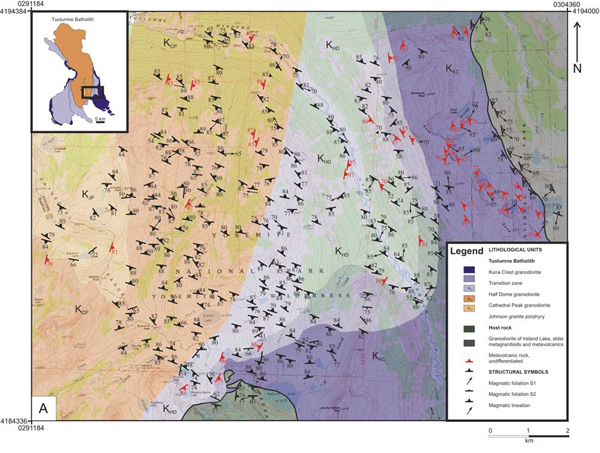This paper is concerned with the development of magmatic, mechanical instabilities in Tuolumne Batholith (TB), Sierra Nevada , California , USA (Figure 1) and the resulting physical accumulation and concentration of K-feldspar megacrysts (phenocrysts).
Figure 1. Map of the Tuolumne Batholith

Map of the Tuolumne Batholith showing four main units and their approximate ages. Inset shows location of batholith in the Sierra Nevada Batholith and California . Two boxes outline areas of detailed work shown in Figure 2.
Evidence for physical accumulation of megacrysts in the TB was presented long ago by Gilbert (1906), but a recent suggestion by Higgins (1999) that megacryst concentrations are due to in situ crystallization during open-system conditions has prompted us to re-examine the existing evidence and search for new evidence. We conclude that K-feldspar megacrysts grew from a melt and that a number of processes led to their physical accumulation . In some places, these accumulations in turn were positively buoyant and continued to rise in the magma chamber while concentrating additional megacrysts. These accumulations formed prior to the development of a late magmatic foliation/lineation (Figure 2), that is before final crystallization of magma in the chamber.
Figure 2. Detailed maps of two areas outlined in Figure 1

Detailed maps of two areas outlined in Figure 1 showing the pattern of two magmatic foliations in these areas, one of which cross-cuts internal contacts. Red symbols show orientations of an older approximately margin-parallel foliation. Black symbols show orientations of a slightly younger magmatic fabric that crosscuts all contacts.
Southern corridor across the four main magmatic units in the TB (Kuna Crest, Half Dome, Cathedral Peak, and Johnson from east to west, respectively); (View, Full size).
Sawmill Canyon area along the eastern margin of the chamber where the KC and HD phases were cut out by intrusion of the CP phase. (View, Full size).
Photo of area mapped in Fig. 2a looking west; (View).
Photo of area mapped in Fig. 2b looking west. (View).
After briefly summarizing the main characteristics of the TB, we provide a review of the evidence for the magmatic origin of K-feldspar megacrysts, mainly because some authors still favor a metasomatic origin [e.g., Dickson, 1996], and then discuss the cause of the large size of the megacrysts — nucleation and growth versus "Ostwald ripening." We then present evidence for megacryst movement and accumulation in granitic magma, and conclude with a discussion of the timing of megacryst growth in the TB, the lack of evidence for grain coarsening or concentration by in situ growth of megacrysts by precipitation from K-rich solutions, and of the physical processes by which the megacrysts were accumulated in the TB.